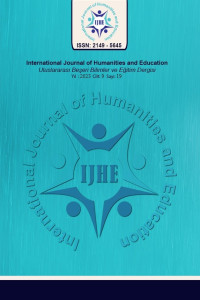Öz
Eski Uygurca gerek dil özellikleri gerek söz varlığı bakımından tarihi Türk dili alanında önemli bir yere sahiptir. Bu dönemde zamirlerin kullanımı da dikkat çekmektedir. Zamirlerin asıl işlevi, cümlede kendilerinden önce ya da sonra gelen şahısları ve varlıkları soru, belirsizlik, işaret gibi çeşitli yönlerden temsil etmektir. Ancak Eski Uygurcada zamirlerin çeşitli ekler, edat ve enklitiklerle kullanılması sonucu sözcük ve sözcük öbekleri meydana gelmiştir. Bu sözcük öbeklerinden biri de zamir köklerinden türeyen sözcüklerin tekrar edilmesiyle oluşan yinelemelerdir. Eski Uygurcada özellikle işret zamirlerinden oluşan sözcüklerin yan yana kullanılmasıyla meydana gelen yinelemelerden bazıları, anlatımı pekiştirmenin yanı sıra asıl anlamlarından ayrı sözcüksel anlam kazanmıştır. Bu çalışmada Eski Uygurca ol ve bu işaret zamirlerinden oluşan yinelemeler sözcükselleşme bağlamında ele alınarak incelenmiştir. Çalışmada öncelikle ikileme ve yineleme kavramları hakkında bilgi verilmiş ardından sözcükselleşme teorisi hakkındaki görüşlere yer verilmiştir. İnceleme bölümünde Eski Uygurca dönemine ait metinlerden seçilen örnek cümlelerden hareketle işaret zamirlerinden oluşan yinelemeler, yapıları ve anlamları bakımından değerlendirilmiştir.
Anahtar Kelimeler
Kaynakça
- Arıcan, A. (2023). Eski Uygurcada Zamirlerin Yapısal ve İşlevsel Bir İncelemesi (Yayımlanmamış Doktora Tezi), Eskişehir: Eskişehir Osmangazi Üniversitesi Sosyal Bilimler Enstitüsü, Eskişehir.
- Arçın, S. M. (2021). Çağdaş Sibirya Türk Lehçelerinde Zamirler. Ankara: Türk Dil Kurumu Yayınları.
- Ayazlı, Ö. (2012). Altun Yaruk Sudur VI. Kitap Karşılaştırmalı Metin Yayını. İstanbul: Türk Dil Kurumu Yayınları.
Öz
Old Uyghur has an important place in the field of historical Turkish language in terms of both linguistic features and vocabulary. The use of pronouns in this period is also noteworthy. The main function of pronouns is to represent persons and entities that come before or after them in various aspects such as question, indefinite and demonstrate. However, as a result of the use of pronouns with various suffixes, prepositions and enclitics in Old Uyghur, words and phrases were formed. One of these phrases is the repetitions formed by the repetition of words derived from pronoun roots. In Old Uyghur, some of the repetitions, which occurred by using the words consisting of demonstrative pronouns side by side, gained a lexical meaning separate from their original meanings as well as reinforcing the expression. In this study, repetitions of Old Uyghur ol and bu demonstrative pronouns were examined in the context of lexicalization. In the study, firstly, information about the concepts of reduplication and repetition is given, and then opinions about the theory of lexicalization are given. In the analysis section, the repetitions consisting of demonstrative pronouns were evaluated in terms of their structures and meanings, based on the sample sentences selected from the texts of the Old Uyghur period.
Anahtar Kelimeler
Kaynakça
- Arıcan, A. (2023). Eski Uygurcada Zamirlerin Yapısal ve İşlevsel Bir İncelemesi (Yayımlanmamış Doktora Tezi), Eskişehir: Eskişehir Osmangazi Üniversitesi Sosyal Bilimler Enstitüsü, Eskişehir.
- Arçın, S. M. (2021). Çağdaş Sibirya Türk Lehçelerinde Zamirler. Ankara: Türk Dil Kurumu Yayınları.
- Ayazlı, Ö. (2012). Altun Yaruk Sudur VI. Kitap Karşılaştırmalı Metin Yayını. İstanbul: Türk Dil Kurumu Yayınları.
Ayrıntılar
| Birincil Dil | Türkçe |
|---|---|
| Bölüm | Araştırma Makalesi |
| Yazarlar | |
| Yayımlanma Tarihi | 30 Nisan 2023 |
| Gönderilme Tarihi | 31 Mart 2023 |
| Yayımlandığı Sayı | Yıl 2023 Cilt: 9 Sayı: 19 |
Uluslararası Beşeri Bilimler ve Eğitim Dergisi
Bu eser Creative Commons Alıntı-Gayri Ticari-Türetilemez 4.0 Uluslararası Lisansı (CC BY-NC-ND 4.0) ile lisanslanmıştır.


